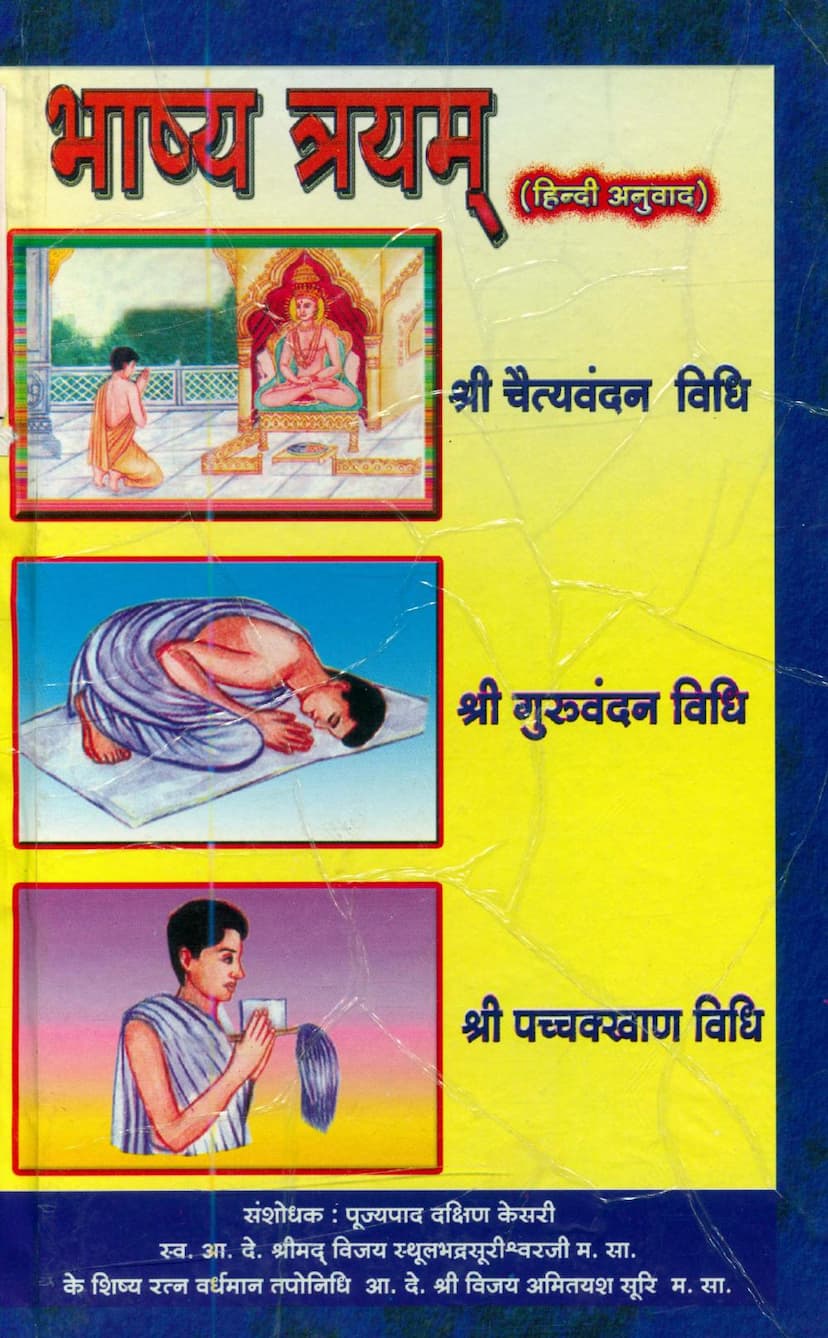Bhashyatrayam Chaityavandan Bhashya, Guruvandan Bhashya, Pacchakhan Bhashya
Added to library: September 1, 2025

Summary
Here's a comprehensive summary of the Jain text "Bhashyatrayam":
Book Title: Bhashyatrayam Chaityavandan Bhashya, Guruvandan Bhashya, Pacchakhan Bhashya Author: Amityashsuri Publisher: Sankat Mochan Parshwa Bhairav Tirth Catalog Link: https://jainqq.org/explore/022300/1
This book, "Bhashyatrayam" (The Three Commentaries), presents a Hindi translation and commentary on three important Jain rituals and practices. It is authored by Acharya Amit Yash Suri, a disciple of Acharya Vijay Sthulbhadra Suri. The book is published by Sankat Mochan Parshwa Bhairav Tirth and is dedicated to the revered gurus mentioned.
Core Content and Purpose:
The primary purpose of this book is to guide practitioners of Jainism in understanding and performing three fundamental rituals:
-
Chaityavandan Bhashya: This section deals with the proper way to worship in a Jain temple (Chaityavandan). It explains the etiquette of entering the temple, the eighty-four "Ashthana" (transgressions or points of impropriety to be avoided), the four "Nikshepa" (categories of invocation for Jin-statues), three types of "Mudra" (gestures), five types of "Abhigama" (approaches to worship), three types of veneration, the significance of the letters and syllables in Namokar mantra and other devotional verses, the faults in "Kayotsarga" (standing meditation), its duration, seven types of Chaityavandana, and the methods of deity worship. It covers these aspects through 24 "Dwar" (sections or approaches) and elaborates on 2074 "Sthan" (points or details).
-
Guruvandan Bhashya: This part focuses on the veneration of spiritual preceptors (Guruvandan). It discusses various forms of veneration, understanding who is worthy of worship and who is not, the distinction between material and spiritual veneration using examples like Sheetala Acharya, the opportune times for veneration, the reasons for veneration, the ritualistic inspection of the "Muhapatti" (mouth cloth) and the body, veneration free from 32 defects, its benefits, the six virtues that arise from veneration, the proper placement for establishing a Guru's presence, thirty-three transgressions related to the Guru's "Avagraha" (space of reverence), and concise methods for morning and evening veneration.
-
Pacchakhan Bhashya: This section elucidates the principles and practices of "Pacchakhan" (vows or resolutions, particularly related to fasting and abstaining from certain foods). It details ten types of Pacchakhan, ten types of "Kal Pacchakhan" (time-bound vows), the method of uttering vows and its variations, four types of food, thirty-three types of "Vigai" (foods to be avoided or taken with caution), six "Bhakshya" (foods that are permissible under certain vow conditions), four "Abhakshya" (foods strictly forbidden), "Mahavigai" (major problematic foods), thirty "Niviyata" (specific ways of preparation or consumption that may or may not be permissible), the different "Bhanga" (aspects or conditions) of Pacchakhan, their purification, and the fruits reaped in this world and the next, illustrated with examples like Dhannil Kumar and Damantrak.
Philosophical Underpinnings:
The book emphasizes the vital connection between knowledge and action for spiritual progress and liberation (Moksha). It draws a parallel between a bird's ability to fly with both wings and eyes, and the soul's journey towards purification. Just as physical well-being requires water for the body, spiritual purification necessitates the words of the Jinagams (Jain scriptures) and adherence to the path shown by the Tirthankaras. The text stresses the importance of humility, wisdom, and equanimity to attain the water of true knowledge.
Structure and Approach:
The "Bhashyatrayam" is structured as a commentary on the "Mula Sutras" (original scriptures). It explains that this work follows the traditional lineage of Jain scholarship, as indicated by the phrase "Suyanusarena" (according to the scriptures). The author, Acharya Devendra Suri, a profound scholar of the four "Anuyogas" (Divisions of Jain Literature: Dravyanuyoga, Ganitanuyoga, Charana Karananuyoga, and Kathanuyoga), has composed these three "Bhashyas" primarily for the benefit of "Baljeev" (young or less knowledgeable souls) to understand the intricate aspects of the Charana Karananuyoga.
The text meticulously breaks down each ritual into numerous "Dwar" (sections) and "Peta Dwar" (sub-sections), providing detailed explanations of rules, principles, and philosophical concepts. It highlights the significance of adhering to these guidelines for spiritual growth and the ultimate goal of liberation.
Key Themes and Concepts:
- Importance of Vinaya (Humility/Respect): Vinaya is presented as the root of Dharma, knowledge, and conduct, essential for spiritual attainment.
- Knowledge and Action: True spiritual progress requires the integration of both theoretical knowledge (Gyan) and practical application (Kriya).
- Stages of Spiritual Development: The text touches upon the contemplation of different states of the soul, from the unawakened to the liberated.
- Detailed Ritualistic Procedures: It provides a granular explanation of the correct way to perform temple worship, Guru veneration, and vows, leaving no room for ambiguity.
- Adherence to Tradition: The commentary emphasizes following the established traditions and teachings passed down through the lineage of Acharyas.
- Moksha (Liberation): The ultimate goal of all these practices is the attainment of Moksha, the liberation of the soul from the cycle of birth and death.
Overall Message:
"Bhashyatrayam" serves as an invaluable guide for Jain practitioners, offering a deep and systematic understanding of essential rituals. It encourages a life of devotion, discipline, and wisdom, emphasizing that by diligently following the prescribed path and adhering to the teachings of the Tirthankaras and their spiritual successors, one can progress on the spiritual journey and ultimately achieve the highest good. The book is a testament to the rich tradition of Jain commentary and its commitment to making complex spiritual principles accessible to all.